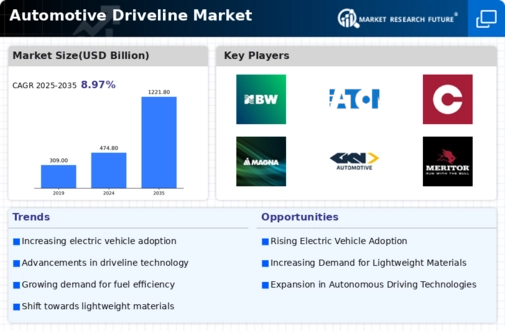Market Growth Projections
The Global Automotive Driveline Market Industry is poised for substantial growth in the coming years. Projections indicate that the market will reach 474.8 USD Billion in 2024, with an anticipated increase to 1221.8 USD Billion by 2035. This growth trajectory reflects a compound annual growth rate of 8.97% from 2025 to 2035. Factors contributing to this expansion include rising demand for electric vehicles, technological advancements, and increased focus on fuel efficiency. The market dynamics suggest a robust environment for innovation and investment, positioning the industry for a transformative decade ahead.
Increased Focus on Fuel Efficiency
The growing consumer awareness regarding fuel efficiency and cost savings drives the Global Automotive Driveline Market Industry. As fuel prices fluctuate, consumers increasingly seek vehicles that offer better mileage and lower operational costs. This trend compels manufacturers to develop driveline systems that optimize fuel consumption without compromising performance. Enhanced driveline technologies, such as hybrid systems and continuously variable transmissions, are gaining traction as they provide improved efficiency. The market's expansion, projected to reach 474.8 USD Billion in 2024, reflects the rising consumer demand for fuel-efficient vehicles, which is likely to persist in the coming years.
Rising Demand for Electric Vehicles
The increasing global emphasis on sustainability and environmental conservation drives the demand for electric vehicles, which significantly influences the Global Automotive Driveline Market Industry. As governments implement stricter emissions regulations, manufacturers are compelled to innovate driveline technologies that accommodate electric powertrains. In 2024, the market is projected to reach 474.8 USD Billion, with electric driveline systems becoming a critical component. This shift not only enhances vehicle efficiency but also aligns with consumer preferences for greener alternatives. By 2035, the market is expected to expand to 1221.8 USD Billion, indicating a robust growth trajectory fueled by electric vehicle adoption.
Regulatory Support for Emission Reductions
Government regulations aimed at reducing vehicle emissions significantly influence the Global Automotive Driveline Market Industry. Stricter emission standards compel manufacturers to innovate driveline technologies that minimize environmental impact. Incentives for electric and hybrid vehicles further stimulate market growth, as consumers are encouraged to adopt cleaner alternatives. The regulatory landscape is evolving, with many countries setting ambitious targets for carbon neutrality. This supportive environment is expected to drive investments in advanced driveline systems, contributing to the market's projected growth to 1221.8 USD Billion by 2035. The alignment of regulatory frameworks with market trends suggests a promising future for the industry.
Technological Advancements in Driveline Systems
Technological innovation plays a pivotal role in shaping the Global Automotive Driveline Market Industry. Advancements in materials, such as lightweight composites and high-strength steel, enhance driveline performance and fuel efficiency. Additionally, the integration of smart technologies, including advanced driver-assistance systems and real-time monitoring, improves vehicle safety and operational efficiency. These innovations are likely to attract investments, as manufacturers seek to differentiate their offerings in a competitive landscape. The anticipated compound annual growth rate of 8.97% from 2025 to 2035 underscores the importance of technological advancements in driving market growth.
Growing Urbanization and Infrastructure Development
Urbanization trends and infrastructure development significantly impact the Global Automotive Driveline Market Industry. As urban populations expand, the demand for efficient transportation solutions rises, leading to increased vehicle production. Governments worldwide are investing in infrastructure projects, enhancing road networks and public transport systems. This development not only facilitates vehicle movement but also encourages the adoption of advanced driveline technologies that improve fuel efficiency and reduce emissions. The interplay between urbanization and infrastructure is expected to bolster market growth, contributing to the projected market size of 1221.8 USD Billion by 2035.



















Leave a Comment